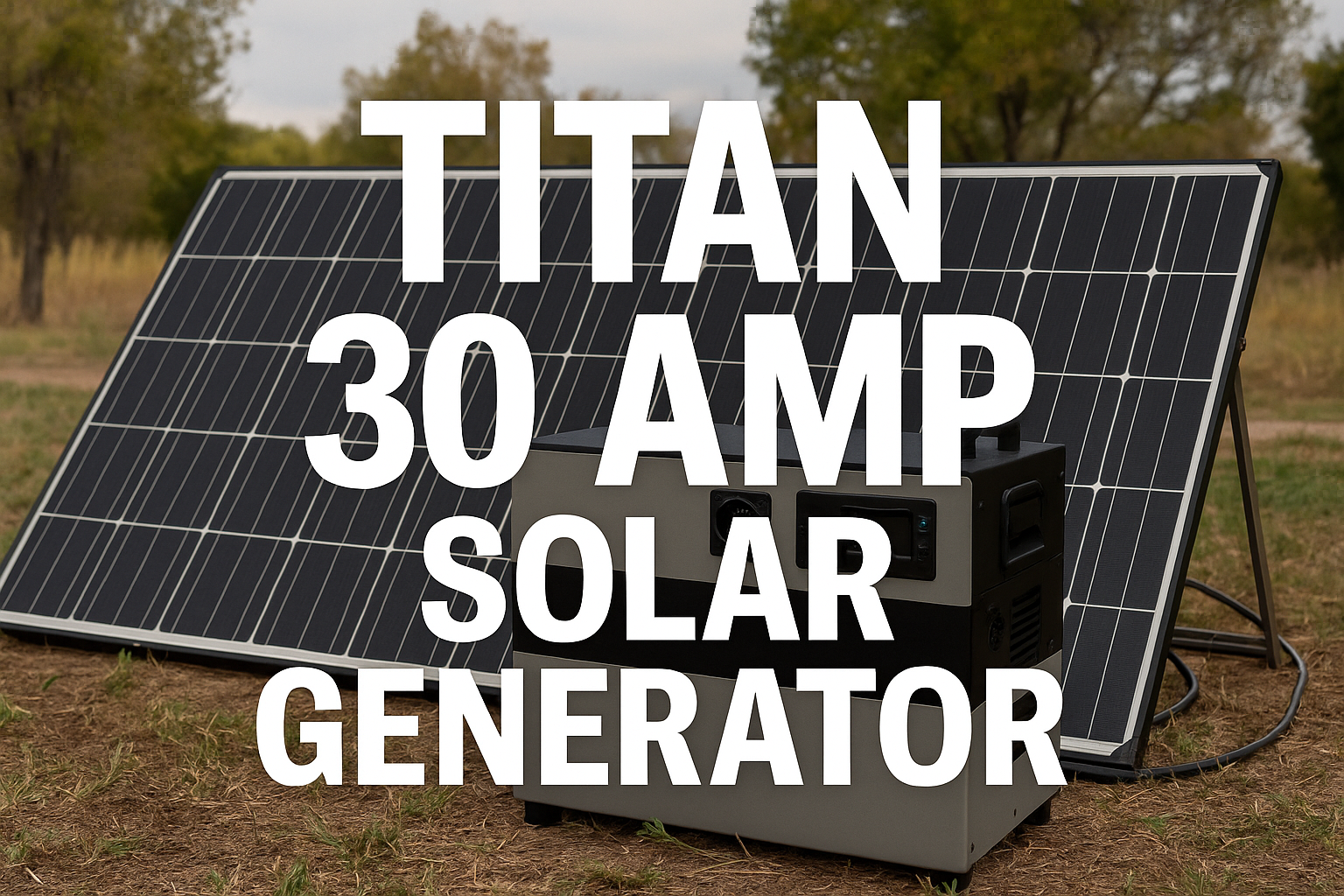Introduction: Why the Titan Stands Out
When you hear the word “Titan,” you expect something strong, reliable, and built to handle the toughest jobs. That’s exactly what the Titan Solar Generator delivers. Made by Point Zero Energy, this solar generator has become one of the most talked-about systems in the off-grid and portable power world.
What makes it different? For starters, it’s not just another battery with a plug. The Titan is modular, expandable, and powerful—capable of running everything from small gadgets to heavy appliances. And its 30-amp RV outlet is a game-changer for campers, van lifers, and anyone who wants true mobile independence.
In this guide, we’ll break down every detail—how it works, what it can power, setup tips, pros and cons, and whether it’s worth the investment for your needs.
The Titan’s Core Design: Modular & Expandable
Unlike many “all-in-one” solar generators that lock you into fixed storage, the Titan is modular by design. That means you can start small and scale up as your power needs grow.
- Power Module: This is the brain of the system. It holds the pure sine wave inverter, dual MPPT charge controllers, LCD screen, and all the output ports. It weighs around 30+ pounds, which makes it manageable to move.
- Battery Packs: Each battery adds 2,000 watt-hours (Wh) of storage. They stack under the power module like building blocks. Need more juice? Just add more batteries—up to six are recommended for best performance.
This stacking system is one of the Titan’s biggest advantages. Instead of buying a whole new generator when you outgrow the first one, you just expand it.
Power Output: Strength Under the Hood
The Titan isn’t shy when it comes to raw power. It’s built to run big appliances without breaking a sweat.
- With one battery: 1,500 watts continuous, 3,000 watts surge.
- With two or more batteries: 3,000 watts continuous, 6,000 watts surge.
To put that in perspective, many competing generators max out at 1,000–1,500 watts continuous. The Titan doubles that with ease. Running things like refrigerators, microwaves, or even small AC units becomes possible.
And because it uses a pure sine wave inverter, the power it delivers is clean and safe for sensitive electronics—laptops, medical devices, and entertainment systems.
Charging Options: Fast & Flexible
One of the most frustrating things about some solar generators is how long they take to recharge. The Titan is different—it’s designed for speed and flexibility.
Here’s how you can charge it:
- Solar Panels
- With one battery: up to 1,000 watts input.
- With two or more batteries: up to 2,000 watts input.
- Thanks to dual MPPT charge controllers, it squeezes every bit of energy from your panels, even in partial sunlight.
- Wall Charging (AC)
- Comes with a 600-watt AC charger.
- Add a second charger to double the speed.
- Car Charging (DC)
- Can top up from a vehicle’s DC port.
- Hybrid Charging
- The Titan lets you combine solar, wall, and DC charging at the same time. That means much faster recovery during emergencies.
This flexibility is what makes the Titan shine in off-grid living and disaster prep. You don’t have to rely on one source—if the sun’s not shining, you can still get power in other ways.
Outputs & Ports: Power for Every Device
The Titan doesn’t skimp on outlets. Whether you’re plugging in a laptop, a power tool, or your RV, there’s a port for it.
- 30-Amp RV Outlet
This is one of the Titan’s headline features. Many solar generators stop at standard AC outlets, but the Titan gives you a dedicated RV plug so you can run your entire RV system. No adapters. No hassle. - Six 120V AC Outlets
Perfect for home appliances—fridge, TV, microwave, fans, and more. - USB Ports (Regular + USB-C)
Ideal for phones, tablets, and modern electronics. - DC Ports
Multiple 12V cigarette lighter ports make it easy to run car accessories, portable fridges, and lighting. - Expansion Port
Lets you connect extra battery packs or external batteries, giving you limitless growth potential.
Having such a wide range of outputs means you can run small gadgets and heavy appliances side by side, which is rare for portable systems.
How the Titan Fits Into Real Life
Now that we’ve seen the specs, let’s talk about how people actually use the Titan in everyday scenarios.
1. Backup Power at Home
The Titan can keep your essentials running during blackouts—fridge, freezer, Wi-Fi router, medical devices, lights, and phone chargers. With one battery, you can run a fridge for about 30+ hours. Add more batteries, and you’re set for multiple days.
2. RV & Van Life
For full-time travelers, the 30-amp RV outlet is a dream. You can run your AC, microwave, and outlets just like you’re at a campsite hookup. With solar panels on your roof, you’re nearly independent from the grid.
3. Off-Grid Living
Tiny homes, cabins, or workshops can use the Titan as a central power hub. Stack up several batteries and add panels, and you’ve got a renewable power station that handles daily living.
4. Prepping & Emergencies
When the grid goes down, gasoline can be scarce. A solar generator like the Titan gives you quiet, renewable power without fuel storage headaches. Pair it with folding solar panels, and you’re prepared for long-term outages.
5. Job Sites
Contractors and remote workers can run tools, lights, and electronics without relying on noisy gas generators. The Titan’s 3,000-watt continuous output makes it suitable for heavy-duty work.
Strengths & Weaknesses: A Balanced View
No generator is perfect, so let’s lay out the Titan’s real pros and cons.
What the Titan Does Best
- High Power Output: 3,000 watts continuous, 6,000 surge—big enough for AC units and power tools.
- Expandable Storage: Start with one battery, stack more as you grow.
- Fast Solar Charging: Up to 2,000 watts input with multiple batteries.
- 30-Amp RV Plug: A rare feature that makes RV living much easier.
- Flexible Charging: Solar, wall, car, or all at once.
- Durability: Lithium batteries with thousands of cycles for long life.
Where It Falls Short
- Weight: Each piece is manageable, but a full system with multiple batteries is heavy (over 200 lbs fully built).
- Cost: Premium power comes with a premium price tag.
- Noise: The cooling fans can be noticeable indoors.
- Size: Not a grab-and-go generator—better for semi-permanent setups.
- No App Control: Unlike some competitors, the Titan doesn’t have a smartphone monitoring app.
Setup & Best Practices
Getting the Titan running is straightforward, but a few tips will help you get the most from it:
- Stack Safely
Always latch the power module securely onto the battery pack. If you’re stacking multiple, keep them level. - Solar Panel Setup
Stay within the safe voltage range (35–145V DC). For two or more batteries, you can max out at 2,000 watts of solar input. - Mix Charging Sources
Don’t be afraid to combine wall + solar charging for faster recovery. - Plan for Weight
If you’re using more than two batteries, consider a cart or dolly for moving the system. - Monitor Usage
The LCD screen shows input, output, and remaining runtime—keep an eye on it to avoid draining your batteries too deep.
Comparing the Titan With Other Solar Generators
Before spending thousands on a solar generator, most people want to know how it stacks up against the competition. Let’s see how the Titan fares against other popular models.
| Feature | Titan Solar Generator | Bluetti AC300 + B300 | EcoFlow Delta Pro | Goal Zero Yeti 3000X |
|---|---|---|---|---|
| Inverter Size | 3,000W cont. / 6,000W surge | 3,000W cont. / 6,000W surge | 3,600W cont. / 7,200W surge | 2,000W cont. / 3,500W surge |
| Battery Capacity | 2,000Wh per module (expandable) | 3,072Wh per module (expandable) | 3,600Wh base (expandable) | 3,032Wh fixed |
| Solar Input | Up to 2,000W | Up to 2,400W | Up to 1,600W | Up to 600W |
| RV Outlet | Yes (30A) | Yes (30A) | Yes (30A) | No |
| Expandability | Unlimited with stackable batteries | Expandable with B300 packs | Expandable with extra Delta units | Limited |
| Portability | Modular but heavy | Heavy, modular | Heavy, single unit | Heavy, single unit |
Takeaway:
The Titan isn’t the absolute lightest, but it offers a sweet spot: powerful inverter, fastest solar input in its class, and true modular design. If portability is your main concern, EcoFlow has sleeker options. But if raw power + expandability matter most, the Titan leads.
Cost Breakdown: What to Expect
The Titan is a premium product, and the pricing reflects that. Still, it’s more flexible than buying a one-size-fits-all generator.
- Base Kit (Module + 1 Battery): Around $3,000–$3,400
- Two Battery Kit: Around $4,500–$4,800
- Complete Bundles with Panels: $5,000+ depending on panel type (rigid vs folding)
- Extra Batteries: Around $2,000 each
At first glance, that’s a serious investment. But consider this: unlike gas generators, the Titan doesn’t need fuel, oil changes, or constant maintenance. Over years of use, it pays for itself in convenience and reliability.
Who Should Buy the Titan?
The Titan isn’t for everyone—but for the right person, it’s almost unbeatable.
- RV Owners → Perfect if you need reliable power on the road, especially with its 30A plug.
- Homeowners → Works great as a backup system for fridges, lights, and essentials.
- Off-Grid Living → Ideal for cabins, tiny homes, or mobile setups where expandability is key.
- Preppers → If you’re preparing for long outages, the Titan provides a renewable, silent power source.
- Remote Workers / Job Sites → Handles power tools and electronics in places without grid access.
If you just need a lightweight generator for camping lights and phone charging, this is overkill. But if you want serious, scalable power, the Titan fits.
FAQs About the Titan Solar Generator
Q: How long does it take to charge the Titan with solar?
With 2,000 watts of solar input and two or more batteries, you can recharge in 2–3 hours of strong sun. With one battery, expect around 3–5 hours.
Q: Can I run my whole house on the Titan?
Not quite. It can handle essentials like fridge, freezer, lights, internet, and medical devices. Running a whole house, including central AC or electric ovens, would drain it too quickly.
Q: How many years will the batteries last?
The lithium batteries are rated for about 2,000 cycles before dropping to 80% capacity. For most users, that’s 5–10 years of regular use.
Q: Is it loud?
There’s no engine, but the cooling fans do make some noise—similar to a desktop computer under load. Much quieter than a gas generator.
Q: Can I fly with it?
No. Airline limits on lithium battery size make it impossible to take something this large on a plane.
Final Verdict: Is the Titan Worth It?
The Titan 30 Amp Solar Generator is not your average portable power box. It’s more like a renewable power plant you can take anywhere.
✔ It’s strong enough to run heavy appliances.
✔ It’s expandable, so it grows with your needs.
✔ It charges faster than most competitors.
✔ And it comes with that unique 30A RV plug, making it perfect for mobile lifestyles.



